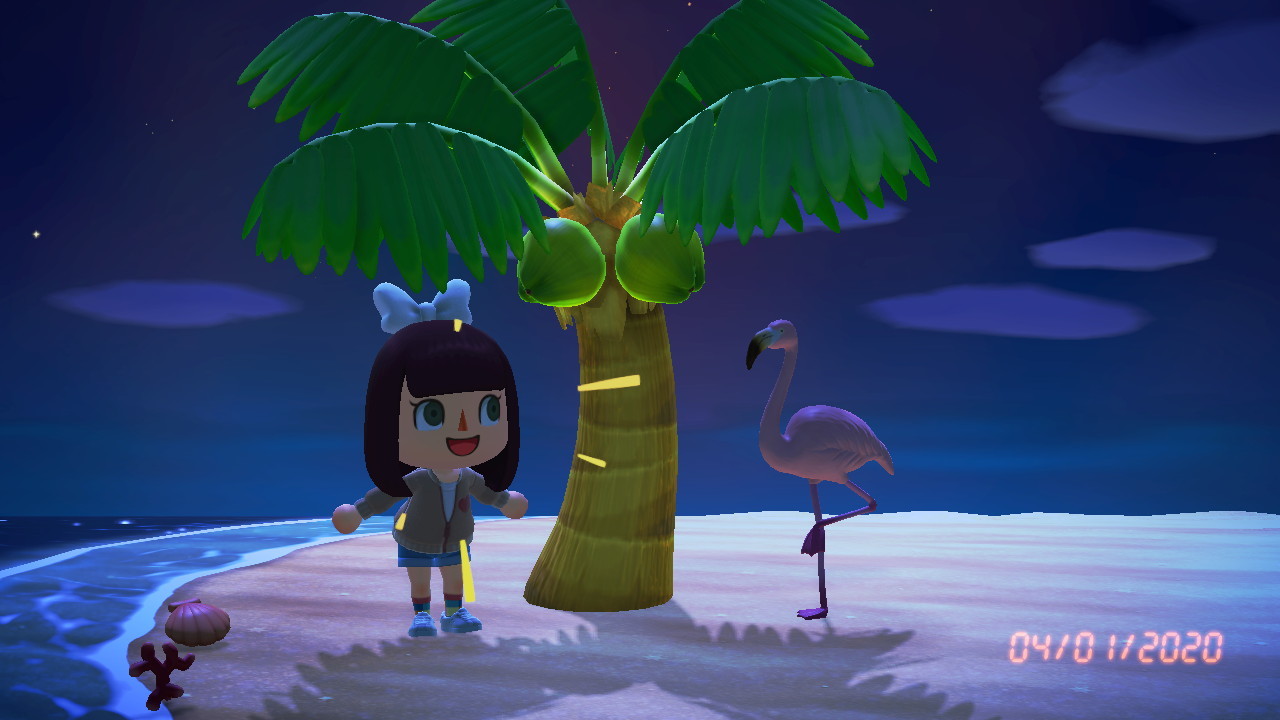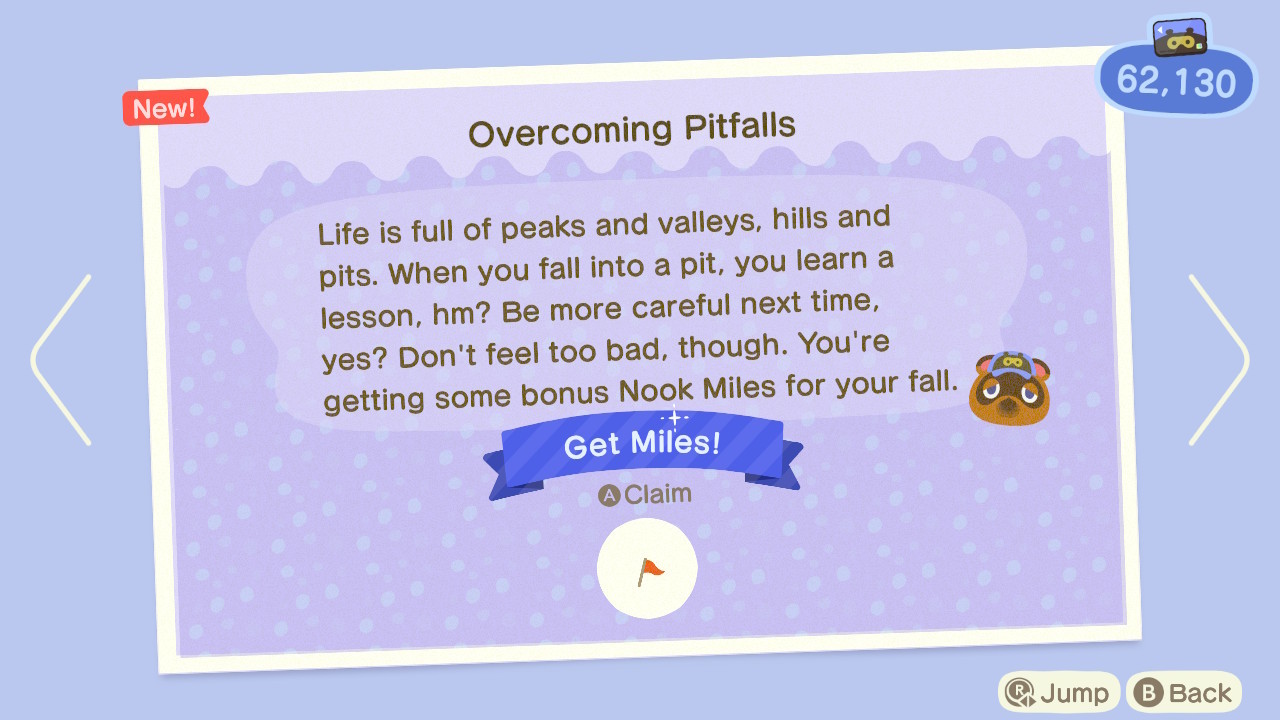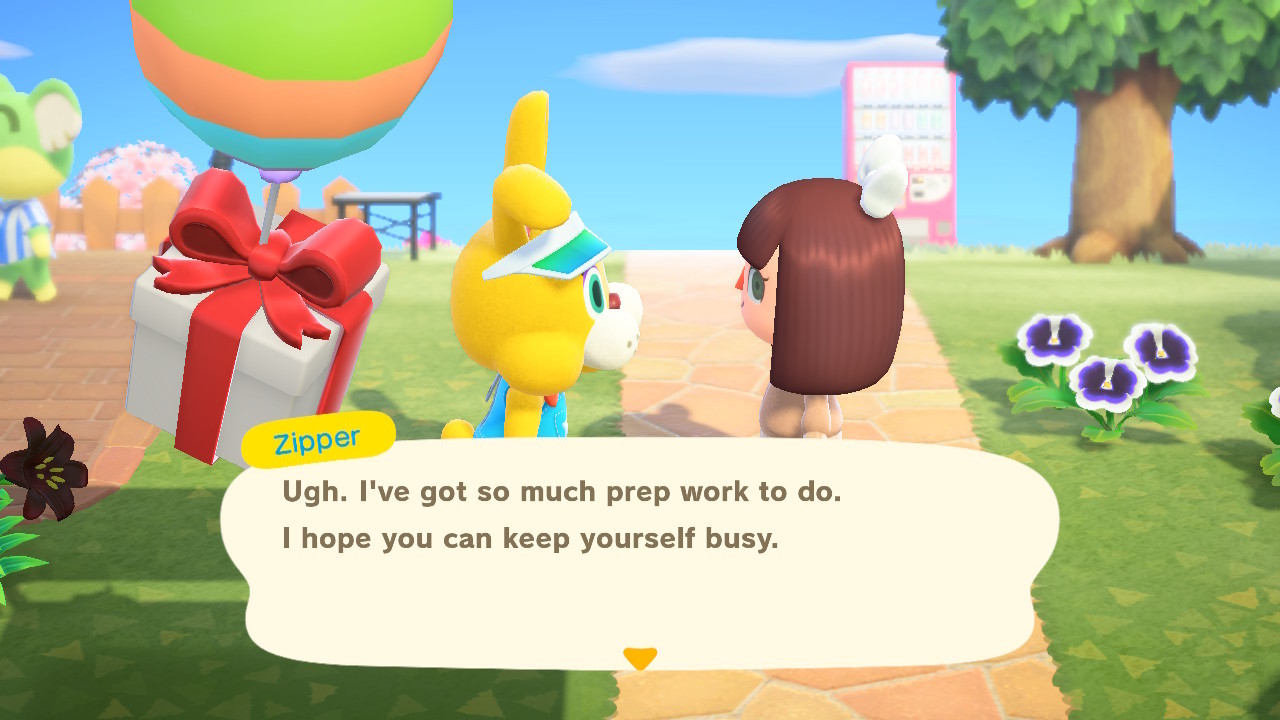A lot has changed in real life since I first started playing Animal Crossing: New Horizons at the end of February, and even since I wrote my review in progress in the middle of March. Having such a wholesome game during an objectively bad time has been something of a blessing for a lot of people, myself included, and I'd be lying if I said it hasn't affected how I play New Horizons. I find myself turning to the game at night when I can't sleep, or during the day when I'm stressed and I need a break. More often than not, an adorable villager or even just a sense of accomplishment from finishing my chores will cheer me up.
But that alone is not what defines New Horizons. The times I go to the game when I'm in a good mood are just as important as the times I'm seeking comfort. Even if I end the day anxious, I wake up excited to see what's new on my island. I can't wait to see who's visiting for the day, to check out the bridge I just built or the new flowers that might be growing or how my new decor looks in the daytime. And I look forward to playing with my friends, trading items and design ideas and hitting each other with nets. New Horizons inspires creative self-expression and embraces kindness and friendship, and that is really what makes it such a joy.
Unlike in previous games, you're not moving to a lived-in town in New Horizons; the island is completely deserted when you and two animals arrive as part of Tom Nook's "getaway package," save for the tiny airport. There's no store or museum, all three of you live in tents, and Tom Nook himself operates out of a tent that he shares with his adorable nephews, Timmy and Tommy. Tom Nook clearly expected this whole thing to be a bit more glamorous (or at least popular), and in typical Tom Nook fashion, one of his first actions is to put you to work collecting tree branches and fruit to make a fire pit and drinks for a welcome party.
The party serves as an introduction to the resource-gathering aspect of New Horizons' new crafting system, but it's also the first of many endearing moments with the animals. In their high-pitched, sped-up way of talking, they chat about friendship and helping one another on the island. It feels like a proper community from the start, despite the small population size and total lack of amenities on the island.
The first few days are all about establishing the basics of any other Animal Crossing town, like the museum and Timmy and Tommy's store, and this sets the stage for crafting. In addition to catching fish and bugs and picking fruit to make money, you also have to spend a good chunk of time at the start gathering resources to craft the furniture requested of you (and, in one case, to build a whole building). Because I wanted to unlock and upgrade things as quickly as possible, I spent hours each day for the first three or four days running around picking weeds, chopping trees for wood, shaking the same trees for branches, hitting rocks for clay, stone, and iron, and selling whatever I couldn't use to craft for some extra bells.
It was a bit overwhelming to do all that in the name of fast-tracking my island progression, but generally, crafting fits neatly into Animal Crossing's established daily chores loop. The act of gathering resources happens simultaneously with the other things I want to do each day--I shake my trees because two of them per day drop furniture instead of fruit or branches, and the branches I do get are a bonus in my search--and actually makes those tasks more lucrative than they were in previous games. Because of this, I don't really have to go out of my way to get the resources I need to craft the furniture, tools, and other items I want.

You start out with an assortment of crafting recipes, and you can get new ones in a variety of ways that, like resource-gathering, are a natural extension of the existing Animal Crossing formula. You can buy some of them, find new ones most days washed up on the beach (in message bottles with letters attached, of course), or get them from your neighbors, among other methods. Finding a new recipe is an exciting reward for going about your day, because crafting goes beyond furniture and tools--I've found some surprising and creative recipes using ingredients I didn't expect, like a giant teddy bear you can craft using regular teddy bears you might buy from Timmy and Tommy.
Complementing all of this is the Nook Miles program, which is based off of real-life travel rewards points. Nook Miles are a separate currency you can use to buy special items and abilities, like new hairstyles and colors you can switch to at a mirror--you can even use Nook Miles to pay off your first loan and get a real house. You get Nook Miles for doing all sorts of things, from getting stung by a wasp to catching 100 fish in a row without failing once. You can also get Nook Miles for shaking furniture from trees, which, if you're counting, is the second extra reward you can get from doing that.
The Nook Miles system adds just enough direction if you aren't sure what to do. I've only felt the need to chase the particularly difficult Nook Miles achievements just for completion's sake; I've gotten most of my Nook Miles just by doing Animal Crossing things and having a nice time, and even though I spend some every day, I still have tons to spare.

While the day-to-day is rich with things to do, overall progression is a bit slow. It took a frustrating 33 days for Nook's Cranny to upgrade where in previous games it would take around 10. The exact requirements for the upgrade aren't totally clear to me, but it feels unnecessarily time-gated, and the unclear prerequisites exacerbated my impatience. There are also buildings and characters, like Brewster and The Roost, that are totally MIA right now. This may be due, at least in part, to Nintendo's live-service approach to New Horizons, in which certain events and characters come to the game via free updates throughout the year. There's definitely potential for more of the series' cast of characters to appear over time, but currently, it's disappointing that so many of them are absent. It's of course fine to cut characters over time as a franchise evolves, but not having much in the way of grander infrastructure to work towards (whether new or returning) puts a damper on the feeling of building up a town from scratch.
In the meantime, it's all too easy to absorb yourself in customization and self-expression. This starts with your character. You can actually choose your appearance for the first time in the series, including skin color, and none of the options are locked to gender. In fact, villagers will exclusively refer to players with gender-neutral pronouns--so when a friend visits, your villagers will talk about them instead of him or her. All hairstyles and clothing options are available to anyone, and you can change your face and hair at any time. Dressing up is further improved by a dedicated outfit menu that lets you preview a full outfit rather than switching in and out of clothes until you find something you like. It has never been easier or more enjoyable to express yourself through your character's appearance in an Animal Crossing game, and I've been having a ton of fun trying on goofy outfits and changing my hair to match just because.

Crafting is, naturally, a big part of customization. You can't craft everything--some kinds of furniture are only available in the shop or found randomly--but there are entire sets of furniture that can only be crafted, and those are largely the pieces that you can further customize with different colors and finishes. At first, I crafted whatever pieces I needed but hadn't been able to buy, like a mirror, but I ended up styling an entire room around furniture I'd crafted and customized. It's that extra bit of flexibility in design that helps inspire creativity and makes each person's home feel unique to them.
More importantly, you can now place furniture pretty much anywhere outside. I found a sand castle in a tree and put it along my beach; later on I got a beach chair and a beach ball and created a whole scene on one part of the shore. I even crafted a cabin-inspired chair I would never put in my house because it fit the woodsy feel I wanted for the hills on my island, which made me realize how much use I could get out of furniture that isn't necessarily my style.
And then there's Island Designer, New Horizons' brand-new terraforming feature. With it, you completely redesign the water features and hills of your island, which lends you an almost intimidating level of creative freedom in your island layout. The tools for waterscaping and cliff construction are a bit tricky to use and master, since it can be hard to gauge where exactly your tool will hit, but it's a powerful creative tool overall. You can also create paths, plazas, flower beds, and more--and it's a huge improvement on the equivalent in past Animal Crossing games, since paths are easy to place and impossible to remove on accident.

Animals will even stick to any paths you put down when walking around, which is just one of the little details that makes them more lively and endearing. I often stop what I'm doing to watch a villager do their thing. Animals will drink tea or stargaze or try to catch bugs, and some of them will put on reading glasses to read books at home. You can even run into them at the museum, where they'll comment on the exhibits. Each of these details gives dimension to villagers; I wasn't sure if I liked Stu, for example, until I stumbled upon him singing an adorable song to himself in the middle of town. I watched him for a very long time, and Flurry even walked up and watched him with me. Now they're my two favorites.
Outside of how cute villagers can be, New Horizons is just beautiful to look at. The museum in particular blew me away; the exhibits are incredibly detailed, and walking through each of them genuinely feels like walking through a real museum. The fossil wing, for example, has lines along the floor that seem to chart evolutionary lines for different animals. Following the lines takes you from one display to the next, and at some points, the camera will even pan to get you a better view of whatever's on display.

The cherry on top is sharing all this with friends. My friends and I trade items and tips and give each other spare crafting recipes. I went on a museum date just like one we'd been on in real life a year ago. It's a joy to visit friends' towns and see how they've decorated their islands--each time I visit someone, I leave with a new idea for my own island. And we all send each other letters and gifts in the game because, right now at least, we can't see each other in real life.
New Horizons has a slower pace even than other Animal Crossing games, and at times, that can feel unnecessarily restrictive. But there's still plenty to do, and each of those activities feeds into the next brilliantly for a rewarding and relentlessly cheerful experience. New Horizons certainly came at the right time, and its strengths are particularly comforting right now. I'm as excited to see what random events await me each morning as I am glad to have it during hard times, and that's sure to keep me coming back for the foreseeable future.









